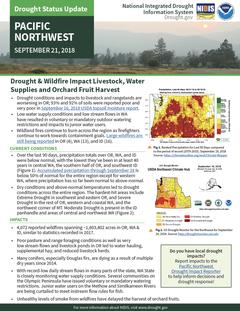Pacific Northwest Drought Status Update - September 21, 2018
Two-page report on September 2018 Pacific Northwest U.S. drought conditions, impacts, and outlook and wildfires.
Drought & Wildfire Impact Livestock, Water Supplies and Orchard Fruit Harvest
- Drought conditions and impacts to livestock and rangelands are worsening in OR; 93% and 92% of soils were reported poor and very poor in September 16, 2018 USDA topsoil moisture report.
- • Low water supply conditions and low stream flows in WA have resulted in voluntary or mandatory outdoor watering restrictions and impacts to junior water users.
- • Wildland fires continue to burn across the region as firefighters continue to work towards containment goals. Large wildfires are still being reported in OR (4), WA (13), and ID (16).
CURRENT CONDITIONS
- Over the last 90 days, precipitation totals over OR, WA, and ID were below normal, with the lowest they’ve been in at least 40 years in central WA, the southern half of OR, and southwest ID. Accumulated precipitation through September 18 is below 50% of normal for the entire region except for western WA, where precipitation has so far been normal to above-normal.
- • Dry conditions and above-normal temperatures led to drought conditions across the entire region. The hardest-hit areas include Extreme Drought in southwest and eastern OR, and Severe Drought in the rest of OR, western and coastal WA, and the northwest corner of MT. Moderate Drought is present in the ID panhandle and areas of central and northwest WA.
IMPACTS
- 4,072 reported wildfires spanning ~1,803,402 acres in OR, WA & ID, similar to statistics recorded in 2017.
- Poor pasture and range foraging conditions as well as very low stream flows and livestock ponds in OR led to water hauling, supplemental hay, and reduced livestock herds.
- Many conifers, especially Douglas firs, are dying as a result of multiple dry years since 2014.
- With record-low daily stream flows in many parts of the state, WA State is closely monitoring water supply conditions. Several communities on the Olympic Peninsula have issued voluntary or mandatory watering restrictions. Junior water users on the Methow and Similkameen Rivers are being curtailed to meet instream flow rules for fish.
- Unhealthy levels of smoke from wildfires have delayed the harvest of orchard fruits.
OUTLOOK
- The 8-14 Day Outlook shows a greater chance of below-normal precipitation across the region. Above-normal temperatures are expected for nearly the entire PNW, except for the northeastern corner of ID for which near-normal temperatures are forecasted.
- The NOAA Climate Prediction Center 3-Month Temperature and Precipitation Outlooks indicate higher probabilities for warmer- and drier-than-normal conditions over most of the region. This is reflected in the September 20, 2018 U.S. Seasonal Drought Outlook which shows drought is likely to persist or develop across most of WA and OR, along the ID/OR border, and in the panhandle along the MT border. There is a chance drought will improve along the WA and OR coast.
- After peaking in August, significant fire potential is expected to stay above normal for southwest and central OR, central WA, and southwest ID, going back to normal by October.
- There are increasing chances for El Niño conditions during fall and winter which tilts the odds toward warmer- and drier-than-normal conditions through the winter in the Pacific Northwest.
NEXT UPDATE
Drought status updates will be issued in the future as conditions evolve. Drought and Climate Outlook Webinars are offered for regional drought early warning systems (DEWS).


